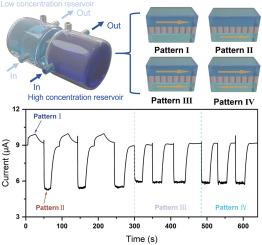流动诱导的氧化铝纳米通道表面电荷增强促进渗透能转换
IF 9
1区 工程技术
Q1 ENGINEERING, CHEMICAL
引用次数: 0
摘要
渗透能作为一种稳定、高效、可持续的清洁能源近年来受到广泛关注。然而,基于纳米通道的渗透能转换系统在实际应用中仍然面临着界面电荷调节的限制。目前的大多数研究都是在稳态条件下进行的,而在复杂的流体扰动环境中,流场、离子分布和界面反应之间的耦合机制仍然知之甚少。在本研究中,我们以氧化铝纳米通道为模型系统,构建了四种不同的流动模式,系统研究了流体流动对离子分布、表面电荷调节和能量转换性能的影响。实验和模拟结果一致表明,仅在高浓度侧施加流动可以显著提高电流输出,提高渗透能转换性能。相比之下,其他流动模式不同程度地降低了能量转换性能。多物理场模拟进一步揭示了流动诱导的离子再分配动态调节纳米通道内的表面电荷密度。具体来说,高浓度侧的流动增强了表面电荷密度,而由此产生的对流流动协同促进了离子传输和功率输出。这些发现阐明了流场-离子分布-界面反应的耦合机制,表明定向流动调节可以显著提高渗透能量收集。这不仅为渗透能量转换装置的设计提供了理论基础,而且为开发智能响应膜和先进的纳米流体能量转换系统铺平了道路。本文章由计算机程序翻译,如有差异,请以英文原文为准。

Flow-induced surface charge enhancement in alumina nanochannels boosts osmotic energy conversion
Osmotic energy has garnered widespread attention in recent years as a stable, efficient, and sustainable clean energy source. However, nanochannel-based osmotic energy conversion systems still face challenges in practical applications due to limited interfacial charge regulation. Most current studies are conducted under steady-state conditions, while the coupling mechanisms among flow fields, ion distributions, and interfacial reactions in complex environments with fluid disturbances remain poorly understood. In this study, using alumina nanochannels as a model system, we constructed four different flow patterns to systematically investigate the effects of fluid flow on ion distribution, surface charge regulation, and energy conversion performance. Both experimental and simulation results consistently demonstrated that applying flow solely on the high-concentration side significantly enhances current output and improves osmotic energy conversion performance. In contrast, other flow modes were found to degrade energy conversion performance to varying degrees. Multiphysics simulations further revealed that flow-induced ion redistribution dynamically modulates the surface charge density within the nanochannels. Specifically, flow at the high-concentration side enhances surface charge density, while the resulting convective flow synergistically promotes ion transport and power output. These findings elucidate a coupled mechanism of flow field-ion distribution-interfacial reactions, demonstrating that directional flow regulation can markedly enhance osmotic energy harvesting. This mechanistic insight not only provides a theoretical foundation for the design of osmotic energy conversion devices but also paves the way for developing smart responsive membranes and advanced nanofluidic energy conversion systems.
求助全文
通过发布文献求助,成功后即可免费获取论文全文。
去求助
来源期刊

Journal of Membrane Science
工程技术-高分子科学
CiteScore
17.10
自引率
17.90%
发文量
1031
审稿时长
2.5 months
期刊介绍:
The Journal of Membrane Science is a publication that focuses on membrane systems and is aimed at academic and industrial chemists, chemical engineers, materials scientists, and membranologists. It publishes original research and reviews on various aspects of membrane transport, membrane formation/structure, fouling, module/process design, and processes/applications. The journal primarily focuses on the structure, function, and performance of non-biological membranes but also includes papers that relate to biological membranes. The Journal of Membrane Science publishes Full Text Papers, State-of-the-Art Reviews, Letters to the Editor, and Perspectives.
 求助内容:
求助内容: 应助结果提醒方式:
应助结果提醒方式:


